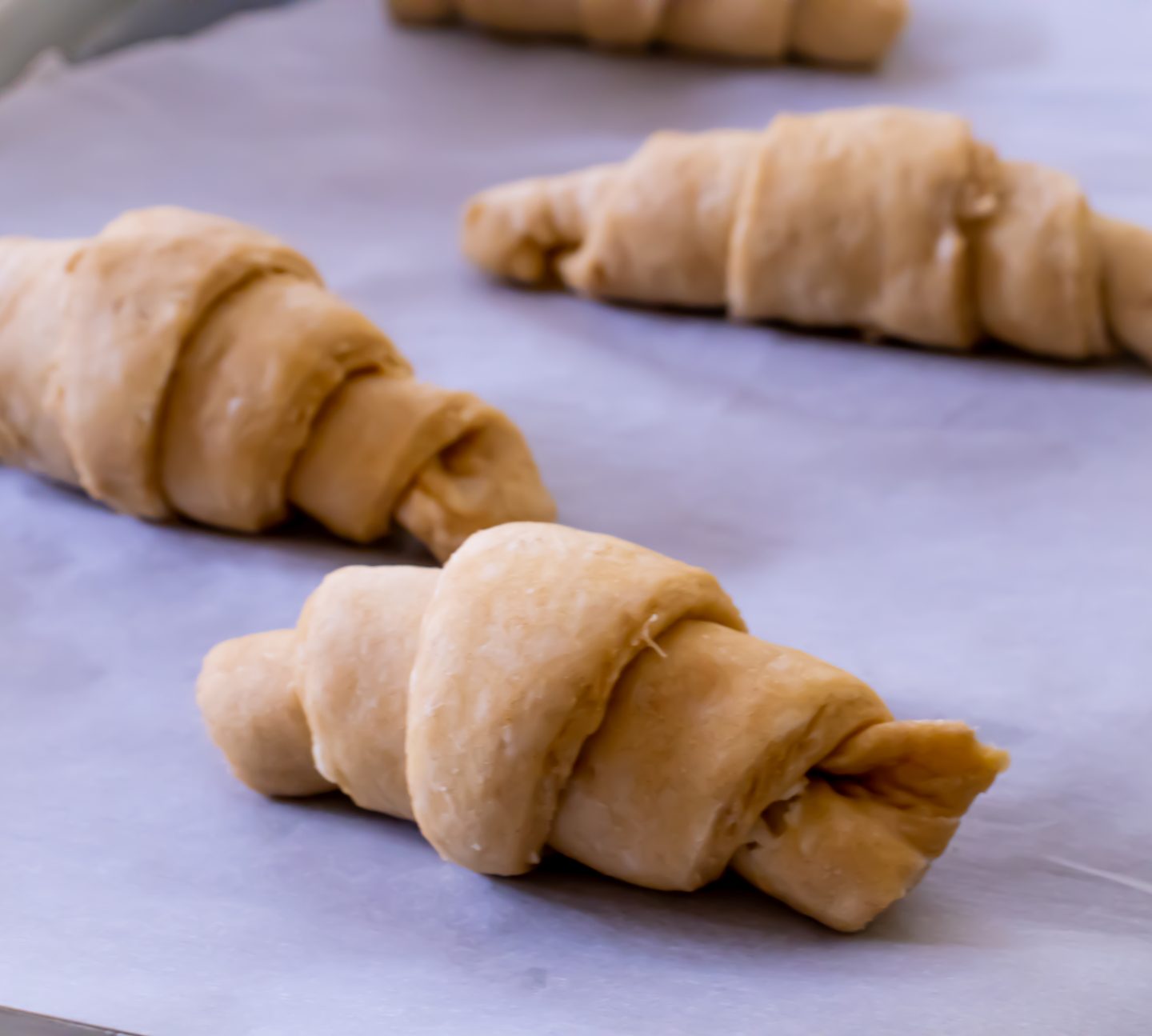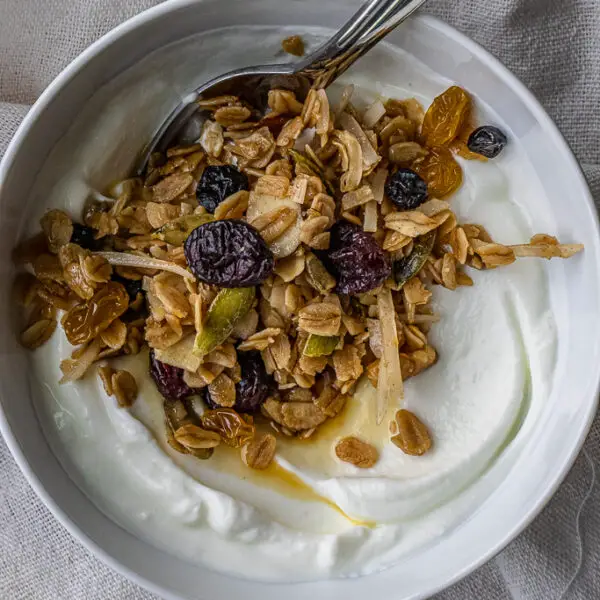
I decided to recreate my croissant and OJ breakfast at home because like everybody else, I have all the time in the world
comfort comes in the form of a warm, home-baked croissant and comfort is one thing we all need right now. when I was in France, I indulged in croissants with zero shame. I ate one every single morning with a glass of fresh squeezed orange juice. once you taste freshly made all-butter croissants, you can’t go back to the artificial stuff, so I decided to recreate my croissant and OJ breakfast at home because like everybody else, I have all the time in the world
I’m realizing that the reason that I enjoy croissants so much is probably because croissants are a labor of love and you can ab-sol-lutely taste the love. they’re not super difficult to make — but they are time-consuming and they require a lot of patience. these took me a full day to make. I started making the dough late-Friday morning and by Saturday morning, they were ready to bake. So if you plan on serving these for brunch, start the day before. building in that time is key because look – there’s an initial rising period (1 hour) + four turns of the dough with and hour rest in between (3 hours) + a 12-16 hour/overnight resting period + a final resting period of 2 hours right before baking.
since we are quarantined, you may be wondering how you spend a day making a croissants guilt-free. the answer is croissant calories don’t count. but if you don’t believe me or you just want another way to kill time, here’s my croissant-making workout :
+ make the dough with flour, yeast, milk, sugar and butter
+ rest the dough for 1 hour (1 mile jog + 25 pushups + 25 burpees + 25 mountain climbers)
+ make a sheet of butter + fold into the dough
+ complete one turn of the dough
+ rest dough for 1 hour (10 minute ab workout)
+ complete the second turn of the dough
+ rest dough for 1 hour (10 minute ab workout)
+ repeat turn + 1 hour rest two more times
+ rest dough overnight (5 mile jog or 90 minute yoga)
+ shape the dough
+ rest the shaped croissants for 2 hours (3 mile jog)
+ eat hella croissants
One more thing before we start, there’s a list of suggested equipment for making these. With the exception of the rolling pin, it’s possible to accomplish making these croissants without my suggested equipment, BUT I highly suggested having these tools on hand because it makes your life so much easier. I don’t even know what my life even was before using a baking mat. literally every time I followed a recipe and they were like “roll the crust out to 9 inches”, I was like HOW AM I SUPPOSED TO KNOW WHETHER MY PIE CERUST IS 9 INCHES?! But now I know every single time because the surface of my baking mat has measurements and conversions for cooking/baking. The second thing is the thermometer. If you’re a pro at proofing yeast and/or can tell when liquid is just at the right temperature for yeast, then you don’t need it. You can also just guess, but I don’t recommend because if you kill your yeast, you have to throw it out and start over wasting perfectly good milk. The grater. You kinda need this to make an even sheet of butter, and preferably a box grater although you can use a hand one. If you’re without a grater, you can soften the butter, mix it together, and spread it out into a rectangle, and refrigerate or freeze it to hold it into place. last one – if you’d don’t have a pastry brush, you’ll be fine. for the longest time, I improvised sans pastry brush. I used a fork or something, which in hindsight is a bit ridiculous, but nobody died.

Okay, so you’ve probably skipped everything that was before this, and that’s okay. But you must, MUST read the entire recipe before embarking on your croissant journey. There are five stages:
+ proofing the yeast
+ making the dough
+ turning the dough
+ shaping the croissants
+ baking the croissants
Make sure that you have the necessary time blocks and that you’re not missing any important equipment or ingredients. I cannot stress this enough.
flaky + buttery croissants.
makes 24 croissants
suggested equipment: silicone baking mat + kitchen thermometer + grater + rolling pin + pastry brush
day 1 ingredients
1 cup milk (whole or half & half works, 2% is probably fine, but not skim or non-fat)
1/2 cup hot water
1 tablespoon active dry yeast (I have not yet tried this recipe with instant yeast)
1/4 cup white granulated sugar
3 3/4 cups all-purpose flour
1 teaspoon kosher salt
1 cup butter (2 sticks), frozen
day 2 ingredients
egg wash (1 egg + 1/4 cup water)
AND obviously – croissant toppings : blackberry preserves / lemon curd / nutella / or anything else that’s delicious
stage one. proofing the yeast. In a microwave-safe mixing bowl combine milk and hot water. What I’m about to say is super important – the milk/water mixture must be somewhere between 105 and 115 degrees F BEFORE adding the yeast otherwise your yeast will fail to activate (too cold) or it will die (too hot). Once it’s reached a temperature between 105 and 155 (I typically shoot for 110-112), lightly stir in the yeast and sugar. Let it sit for 10 minutes (after 10 minutes it should be pretty foamy-looking).
stage two. making the dough. With a spoon, stir in flour and salt. transition to using your hands to incorporate all of the ingredients together. Form into a ball and place in a lightly oiled bowl to rest in the refrigerator for 1 hour.
stage three. turning the dough. Using a box grater, grate 2 sticks of frozen butter onto a large piece of plastic wrap. Flatten the butter into a large flat, compact rectangle, about 8” x 5”. Refrigerate your “sheet of butter” for 30 minutes.
Transfer the chilled dough out onto a lightly floured surface and roll into a rectangle, 16″ x 10″. Unwrap the cold sheet of butter and place in the center of the dough rectangle. Fold the dough into thirds over the butter, like you’re folding up a letter. Now, complete one “turn” – roll the folded rectangle back into a 16” x 10” rectangle and fold like a letter again. Wrap in plastic and refrigerate for 1 hour
After an hour, complete another turn: roll the folded rectangle back into a 16” x 10” rectangle and fold like a letter again. Refrigerate for an hour. Repeat two more times to complete a total of 4 turns.
After the final turn, cut the dough rectangle into quarters. Wrap the quarters in plastic wrap and refrigerate for 12-16 hours.
stage four. shaping the croissants. Removing one quarter of the dough from the fridge at a time, roll it out on a floured surface into a large rectangle. Cut the large triangle into 3 smaller rectangles, then cut each small rectangle in half diagonally forming 6 triangles.
Lightly stretch out each triangle and then starting at the most stretched out corners, cut a small slit at the base and roll the triangle toward the opposite side.
Place the rolled croissants on a cookie sheet lined with parchment paper (or lightly greased with butter). Leave to rise at room temperature for 2 hours.
stage five. Baking the croissants. Preheat the oven to 425 degrees F. working in batches, brush each croissant with the egg wash mixture (egg + water) and bake croissants. As soon as you place the pan in the oven, lower the oven temperature to 400 degrees and bake for 10 minutes. Lower temperature again to 350 degrees F and bake for another 7-10 minutes until the croissants are brown and risen.
the most important stage. eating. Serve warm and top with jams + nutella + or whatever your heart desires. Also, share? Or don’t?




